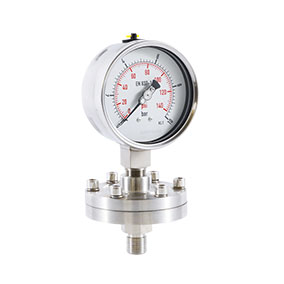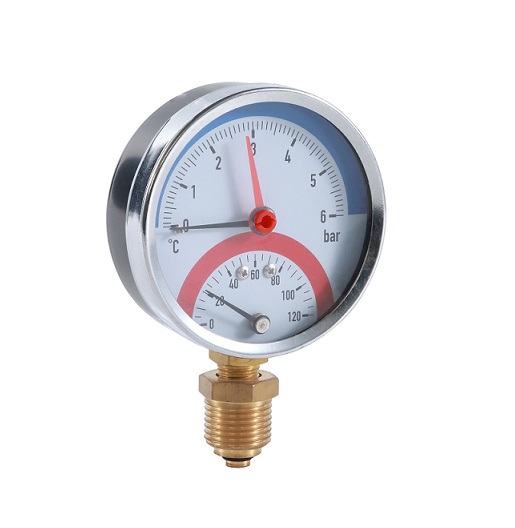The difference between a bayonet pressure gauge and an ordinary pressure gauge
As a common measuring tool in industry, pressure gauges are widely used to monitor pressure in liquid and gas systems. According to different design and functional requirements, there are many types of pressure gauges on the market, of which bayonet pressure gauges and ordinary pressure gauges are two common and representative types. Although their basic functions are similar, there are significant differences in installation methods, usage scenarios, and measurement accuracy. Understanding their differences will help users choose the most suitable pressure gauge according to specific needs.
1. Definition
The Bayonet Pressure Gauge is a pressure measurement tool designed for industrial environments. It measures pressure by connecting the pressure gauge to the interface of the pipeline system. The biggest feature of the Bayonet Pressure Gauge is its special interface design, which uses a bayonet connection for easy installation and disassembly, so it is also called a “bayonet installation pressure gauge”.
The ordinary pressure gauge (Bourdon Tube Pressure Gauge) is a traditional pressure measurement tool, usually consisting of a bent metal tube (i.e., “Bourdon tube”) and an indicator dial. As the pressure changes, the degree of bending of the Bourdon tube changes, which drives the pointer to move on the dial to indicate the pressure value. Ordinary pressure gauges are usually fixed to the measuring point by threaded connections.
2. Advantages
Advantages of bayonet pressure gauges:
Quick installation and disassembly: Since the installation of the bayonet pressure gauge adopts a bayonet connection, this design allows the pressure gauge to be quickly installed and disassembled, which is suitable for occasions of frequent replacement, maintenance and inspection.
Save space: The bayonet connection is usually more compact than the threaded connection, which helps to save installation space, especially in space-constrained equipment.
Improve safety: The bayonet pressure gauge is usually equipped with a locking device, which helps prevent the equipment from loosening due to excessive pressure and provides higher safety.
Advantages of ordinary pressure gauges:
Simple structure and low cost: The design and manufacturing process of ordinary pressure gauges is relatively simple, so the cost is low and it is suitable for most ordinary applications.
Wide range of applications: Due to the reliability of the structure of ordinary pressure gauges, it is widely used in many industries, including chemical, machinery, petroleum and other fields.
High measurement accuracy: The Bourdon tube design of the ordinary pressure gauge makes it more sensitive to pressure changes and can provide high-precision pressure measurement results.
3. The difference between the bayonet pressure gauge and the ordinary pressure gauge
Installation method:
The bayonet pressure gauge adopts a bayonet connection, which is easy to install and can be quickly disassembled, which is very suitable for applications that require frequent maintenance and replacement.
Ordinary pressure gauges use threaded connections, which are more complicated to install and require tools for disassembly. Therefore, in some occasions that require frequent replacement or cleaning, it may not be as convenient as the bayonet pressure gauge.
Applicable scenarios:
The bayonet pressure gauge is more suitable for environments where space is limited or requires rapid replacement and maintenance. It performs well in modern industrial equipment and compact systems.
Ordinary pressure gauges are suitable for most conventional industrial environments, especially those that require high accuracy and do not require frequent replacement. It has a wide range of applications and is suitable for the measurement of liquid and gas pressure.
Accuracy and reliability:
Ordinary pressure gauges usually have high accuracy, especially in measurements under low and high pressure conditions, they are relatively stable and suitable for industrial applications requiring high accuracy.
Although the bayonet pressure gauge also has good measurement capabilities, it usually performs slightly worse than ordinary pressure gauges under high precision requirements. Therefore, it is more suitable for applications with medium precision requirements.
Safety and durability:
The bayonet connection design of the bayonet pressure gauge makes it safer in certain high-pressure environments, but at the same time, it is necessary to ensure that the bayonet connection part will not loosen or be damaged.
Although the ordinary pressure gauge has a sturdy structure, due to the threaded connection, it is necessary to pay attention to whether there is a sealing problem during its installation and use to avoid leakage in a high-pressure environment.
Bayonet pressure gauges and ordinary pressure gauges have their own advantages and are suitable for different application scenarios. Bayonet pressure gauges are suitable for environments with limited space or frequent replacement due to their ease of installation and high safety; while ordinary pressure gauges are widely used in industries with high precision requirements due to their high accuracy and reliability. When choosing a pressure gauge, users should make the best decision based on actual needs, taking into account factors such as its accuracy, ease of installation, and usage environment.




